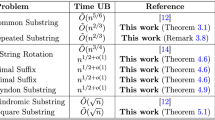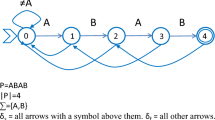Abstract
The wavelength-based machine, or simply w-machine, is an optical computational model, which is designed based on simultaneous movement of several wavelengths in a single light ray, and simultaneous effect of simple optical devices on them. In this paper, we investigate nonuniform complexity classes of w-machine, based on three complexity measures, namely, size, time, and word length. We show that the class of languages which can be generated by constant size nonuniform w-machines contain infinitely many Turing undecidable languages. Also, we show that polynomial size nonuniform w-machines generate all NP languages, and every NP-hard language requires at least polynomial time and polynomial size nonuniform w-machines to be generated. We prove that the class of languages which can be generated by polynomial size nonuniform w-machines is equal to NP/poly, and almost all languages require exponential size and polynomial time nonuniform w-machines to be generated.




















Similar content being viewed by others
Explore related subjects
Discover the latest articles, news and stories from top researchers in related subjects.References
Barakat R, Reif JH (1987) Lower bounds on the computational efficiency of optical computing systems. Appl Opt 26(6):1015–1018
Beigel R, Kummer M, Stephan F (1995) Approximable sets. Inf Comput 120(2):304–314
Chow TY (2011) Almost-natural proofs. J Comput Syst Sci 77(4):728–737
Demtrder W (2011) Atoms, molecules and photons: an introduction to atomic- molecular- and quantum physics, 2nd edn. Springer, Berlin
Dolev S, Fitoussi H (2010) Masking traveling beams:optical solutions for np-complete problems, trading space for time. Theor Comput Sci 411:837–853
Goliaei S (2012) Unconventional computing, an optical approach. Ph.D. Thesis, Tarbiat Modares University
Goliaei S, Foroughmand-Araabi MH (2012) Lower bounds on the complexity of the wavelength-based machine. In: Durand-Lose J, Jonoska N. (eds) Lecture notes in computer science, vol 7445. Springer, Berlin, Heidelberg 94–105
Goliaei S, Jalili S (2009) An optical wavelength-based solution to the 3-SAT problem. In: Dolev S, Oltean M, (eds) Lecture Notes in Computer Science. Volume 5882. Springer-Verlag Berlin Heidelberg, pp 77–85
Goliaei S, Jalili S (2012) An optical solution to the 3-SAT problem using wavelength based selectors. J Supercomput 62:663–672
Goliaei S, Jalili S (2013) An optical wavelength-based computational machine. Int J Unconv Comput 9:97–123
Goliaei S, Jalili S, Salimi J (2012) Light-based solution for the dominating set problem. Appl Opt 51(29):6979–6983
Haist T, Osten W (2007) An optical solution for the traveling salesman problem. Opt Express 15(16):10473–10482
Maier M (2008) Optical switching networks, 1st edn. Cambridge University Press, Cambridge
Meinders ER, Mijiritskii AV, van Pieterson L, Wuttig M (2006) Optical data storage: Phase-change media and recording, 1st edn. Springer, Berlin
Muller DE (1956) Complexity in electronic switching circuits. IRE Trans Electron Comput 5(1):15–19
Muntean O, Oltean M (2009) Deciding whether a linear diophantine equation has solutions by using a light-based device. J Optoelectron Adv Mater 11(11):1728–1734
Oltean M (2008) Solving the hamiltonian path problem with a light-based computer. Nat Comput 6(1):57–70
Oltean M (2009) Light-based string matching. Nat Comput 8(1):121–132
Oltean M, Muntean O (2008) Exact cover with light. New Gener Comput 26(4):329–346
Oltean M, Muntean O (2009) Solving the subset-sum problem with a light-based device. Nat Comput 8(2):321–331
Reif JH, Tyagi A (1990) Energy complexity of optical computations. In: Proceedings of the 2nd IEEE symposium on parallel and distributed processing, pp 14–21
Reif JH, Tygar D, Yoshida A (1994) The computability and complexity of ray tracing. Discret Comput Geom 11:265–287
Shannon C (1949) The synthesis of two-terminal switching circuits. Bell Syst Tech J 28(1):59–98
Wegener I (2005) Complexity theory: exploring the limit of efficient algorithms, 1st edn. Springer, Berlin
Woods D, Gibson J (2008) Lower bounds on the computational power of an optical model of computation. Nat Comput 7(1):95–108
Woods D, Naughton TJ (2005) An optical model of computation. Theor Comput Sci 334(1–3):227–258
Woods D, Naughton TJ (2008) Parallel and sequential optical computing. In: Dolev S, Haist T, Oltean M (eds) Lecture notes in computer science, vol 5172. Springer, Berlin, Heidelberg, pp 70–86
Woods D, Naughton TJ (2009) Optical computing. Appl Math Comput 215(4):1417–1430
Yu FTS, Jutamulia S, Yin S (eds) (2001) Introduction to information optics, 1st edn. Academic Press, Boston
Author information
Authors and Affiliations
Corresponding author
Rights and permissions
About this article
Cite this article
Goliaei, S., Foroughmand-Araabi, MH. On the complexity of nonuniform wavelength-based machine. Nat Comput 13, 269–283 (2014). https://doi.org/10.1007/s11047-014-9412-2
Received:
Accepted:
Published:
Issue Date:
DOI: https://doi.org/10.1007/s11047-014-9412-2




